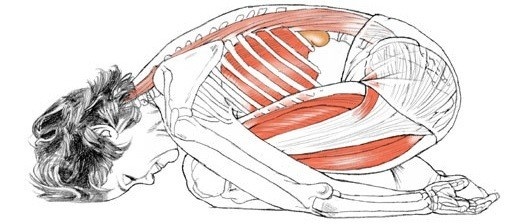Balasana

Notes
Gravity draws the yielding body deeper into this position. One goal of this pose is to bring the sitting bones to the heels and the forehead to the floor. To do so, many muscles have to lengthen: the extensors of the spine, gluteus maximus, piriformis and other rotators, hamstrings, gluteus medius and minimus (because of hip adduction), tibialis anterior, peroneus tertius, extensor digitorum longus and brevis, and extensor hallucis longus and brevis in the feet.
Variations include widening the knees (hip abduction), which can create more neutral extension in the spine and make room for the belly; extending the arms overhead; clasping the heels with the hands; crossing the arms under the forehead; and turning the head to one side.
Sometimes there is congestion in the fronts of the hip joints. It can be caused by using the hip flexors to pull the body down toward the thighs, rather than allowing gravity to create that action. The use of props can assist in this release.
If the extensors of the toes are tight or if there is a lack of mobility in the bones of the feet, restriction can also be felt in the tops of the feet. In addition, weakness in the intrinsic muscles of the feet often results in cramping in this and similar positions (such as virasana and vajrasana).
Images from the book Yoga Anatomy by Leslie Kaminoff & Amy Matthews displayed on this website are used under license.

Love Learning with Leslie?
Study with him personally online, from anywhere in the world.
Which course is right for me?
